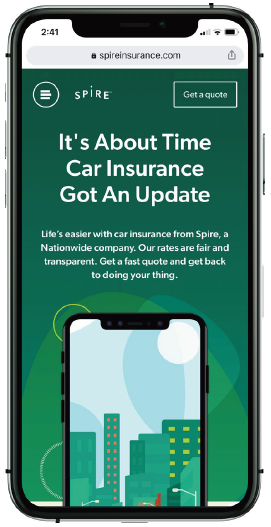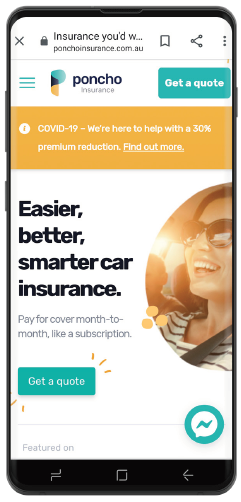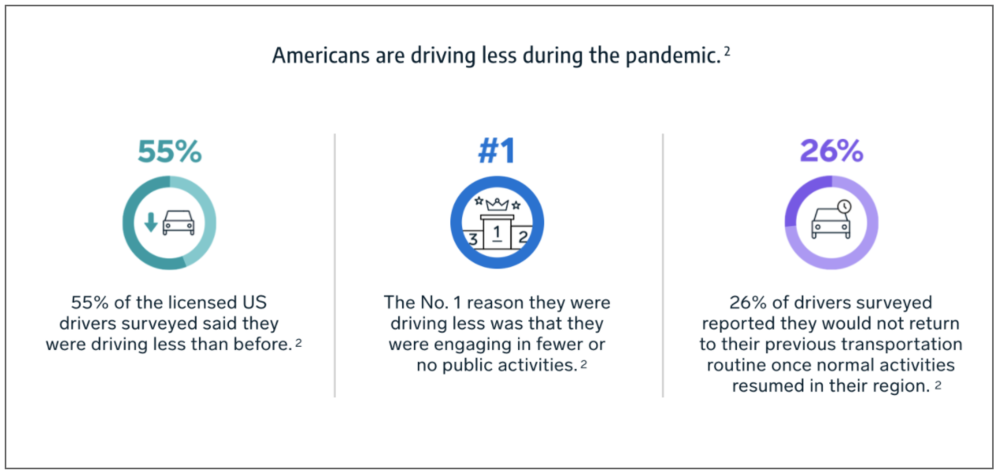Why personal auto insurance is changing, and how insurers can compete
November 19, 2020
Customer driving habits and expectations have rapidly evolved
Consumers live on the Internet — whether it’s ordering groceries, connecting with friends and family, or working remotely — and are rewarded for this online behavior with choice, personalization, and convenience. These perks have created the expectation that consumers can easily engage with any business online at any time, from anywhere. But when it comes to buying auto insurance, that expectation is often met with a frustrating reality involving a labored application process, quotes that don’t make sense, and time spent on the phone waiting to speak with an agent. Couple these frustrations with rapidly shifting driving patterns (in part due to the pandemic), the demand for digital-first experiences, and personalized coverage, and auto insurers are faced with an ever-widening customer-satisfaction gap. Closing that chasm between customer expectations and their existing product offerings is an ongoing challenge facing auto insurers.
Upstarts step in with convenience and flexibility
Tried-and-true insurance brands offer dependability and security but tend to lack the agility, speed, and simplicity that modern carriers can. And while some new insurtechs may not be household names or have long-standing reputations, they do offer flexible coverage and convenient self-serve experiences that most legacy insurers can’t yet offer because their underlying technology doesn’t support modern business models.
-
For drivers who are focused on affordability and convenience, upstarts like Root Insurance that offer personalized, app-based products are appealing alternatives to traditionally overly complicated and opaque coverage plans.
-
Another upstart, Metromile, provides usage-based insurance allowing their customers to pay by the mile. With changing driving patterns UBI policies are becoming more popular as they offer flexibility and transparent rates.
Legacy insurers who don’t want to see their loyal customer-base further erode have created auto insurance products and brands for today’s digitally-savvy consumer.
-
Nationwide developed a straightforward digital-first insurance platform that caters to millennials: Spire. Using the Spire mobile website, customers can secure auto insurance coverage in under a minute by scanning their driver’s license and answering only four questions. Spire’s jargon-free coverage explanations and telematics-based pricing ensure that customers understand how their premiums are calculated.
-
Similarly, Australia’s largest insurer, IAG, developed Poncho insurance to provide easy and flexible personal auto coverage for their policyholders. Through its online self-service portal, applicants can quickly get a quote, and customers can manage their policy and make any changes to their coverage as needed.


Insurers can better compete with a modern core
For insurers looking to remain competitive among a sea of insurtech incomers, there’s a simple solution: make the purchasing process more transparent, personalized, and easy to use by leveraging modern core technology. Doing so comes with plenty of benefits:
-
A modern, personalized insurance buying experience for the customer. Policyholders want a short, frictionless application and quote process — ideally, one that is self-service, optimized for mobile environments, and available through various distribution channels. With the right core platform enabling flexibility and omnichannel interactions, insurers can meet customers where they’re most comfortable and leverage data to provide customers with more personalization and relevant communication. Convenience and increased engagement will drive customer loyalty and result in better customer retention and acquisition.
-
Improved operational efficiencies, seamless data integration, and faster product development. Most legacy systems can’t integrate with modern data sources like telematics and have limited extensibility and flexibility. A modern core platform can easily connect to multiple data sources to deliver better risk assessment and pricing. Additionally, an agile core can streamline underwriting, the customer application process, payments, endorsements, and document generation, shortening customer wait times.
Socotra is steering insurers’ path to modernization
Socotra’s cloud-native core platform gives insurers the tools they need to compete against new startups and increase their market share. With open APIs and a flexible product model, Socotra is easily configurable and can be used to rapidly develop and launch auto insurance products in any country for any distribution channel. Socotra’s continuously-improving platform means that providers can also enjoy a lower total cost of ownership (TCO ) — there is nothing to maintain and upgrades are continuous, automatic, and free.
In addition to assessing, managing, and mitigating risks on behalf of customers, auto insurers should assess, manage, and mitigate the effects of evolving customer needs on their business. Insurers must invest in tools that enable them to adapt to modern customer expectations by introducing personalization, flexibility, and convenience. Some of the world’s largest insurers have launched new personal auto insurance products built on Socotra’s modern core platform — Nationwide launched Spire and IAG Satellite launched Poncho Insurance in 2019. These legacy insurers now have the flexibility and agility they need to appeal to modern customers and their changing needs.
Ready to transform your personal auto insurance business? Watch our demo to see what agility and flexibility really look like with a modern core platform.

